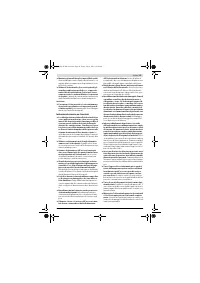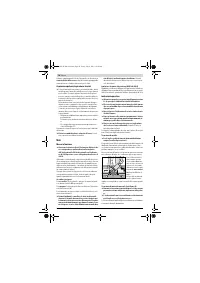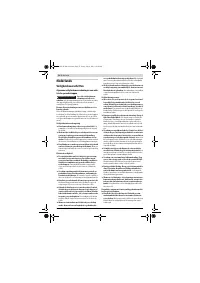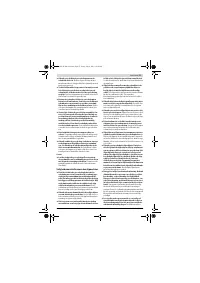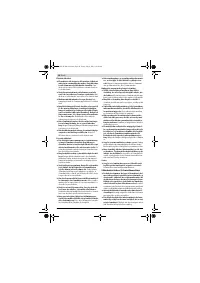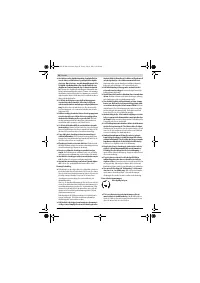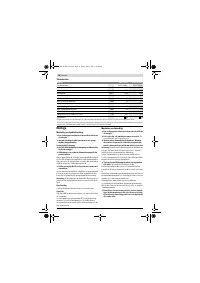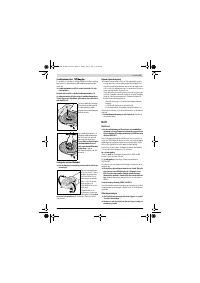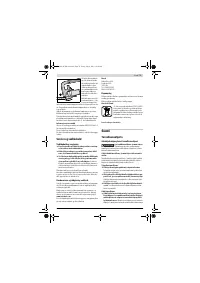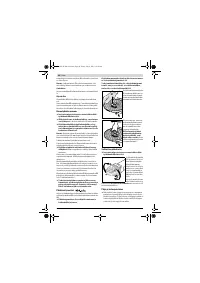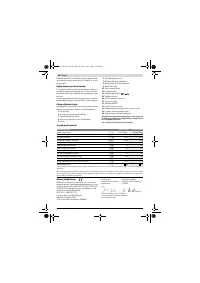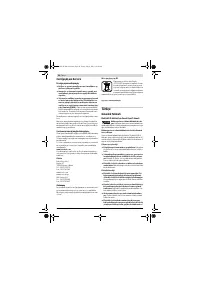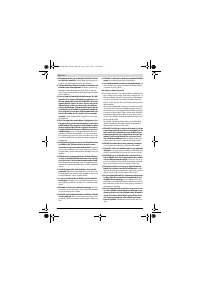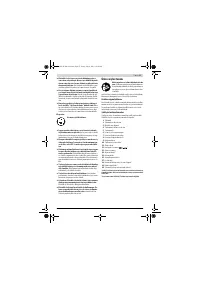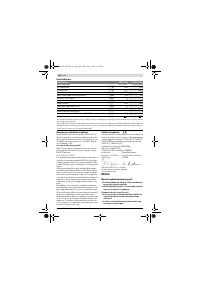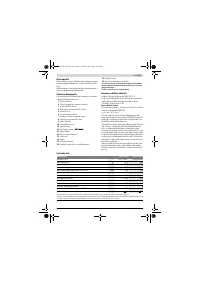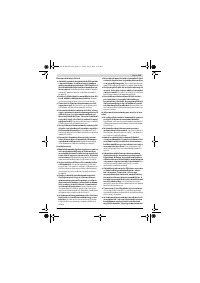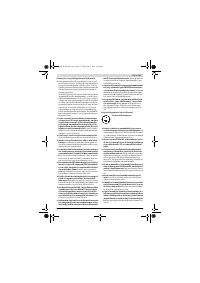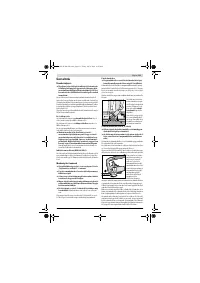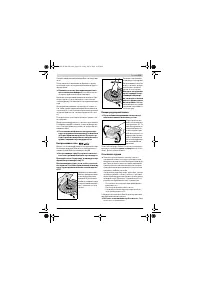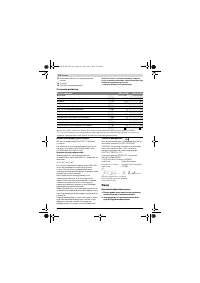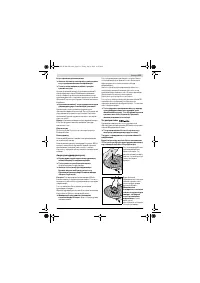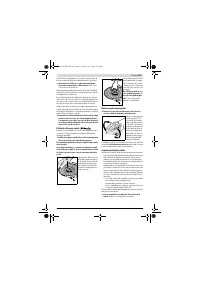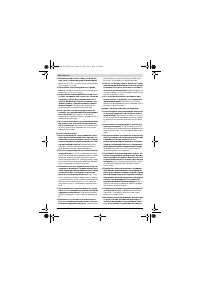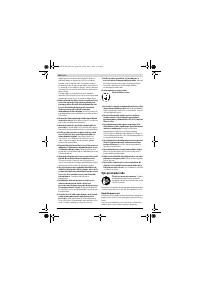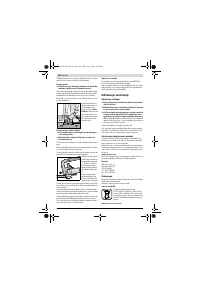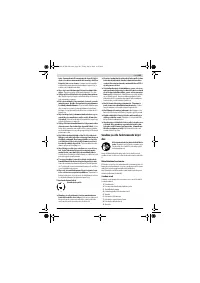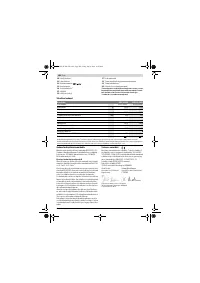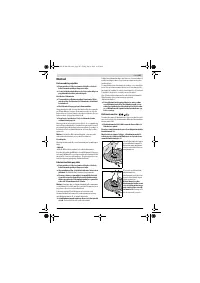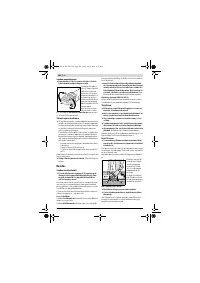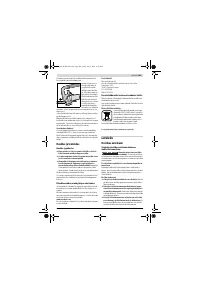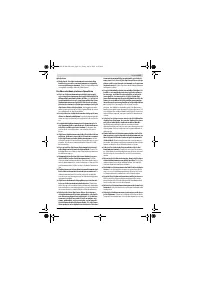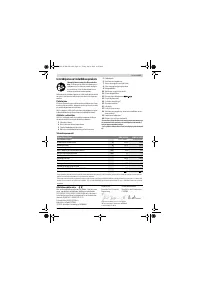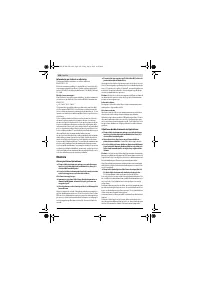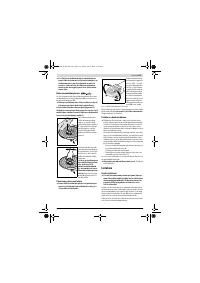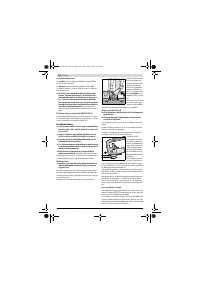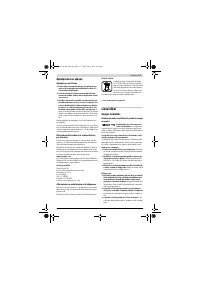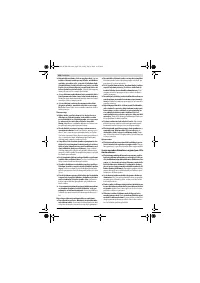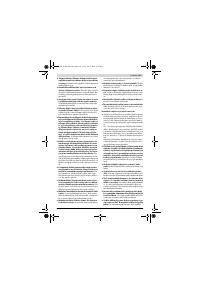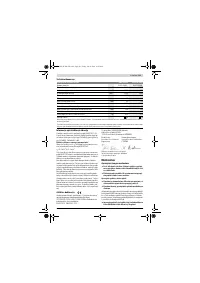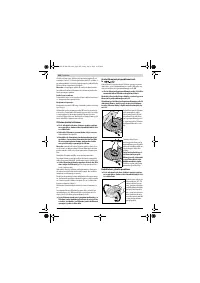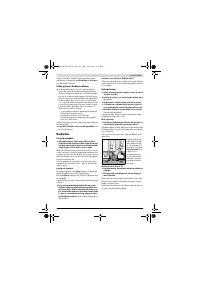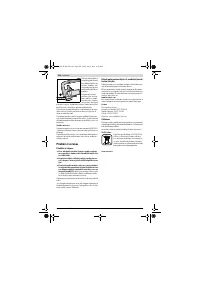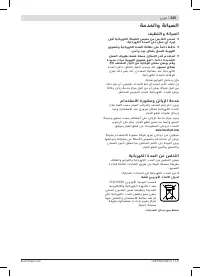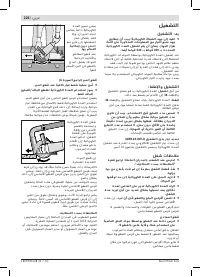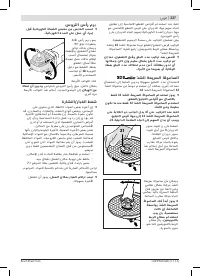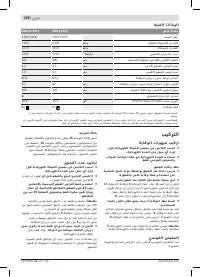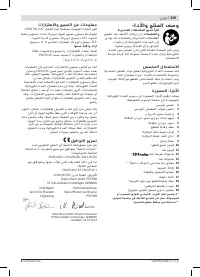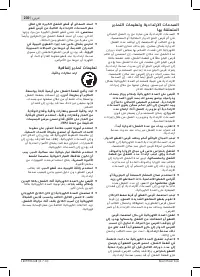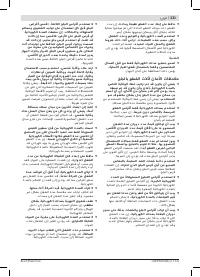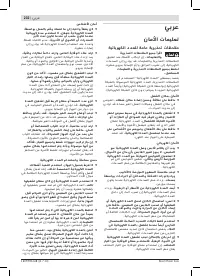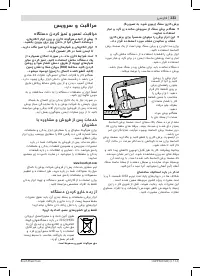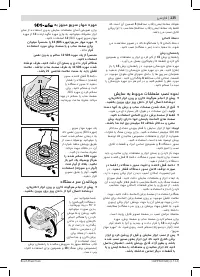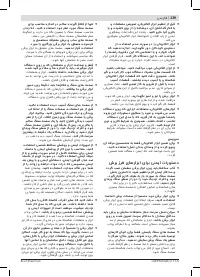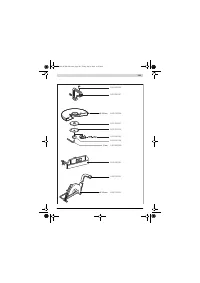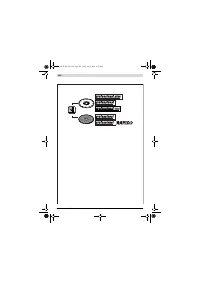Шлифмашины Bosch GWS 24-300 J - инструкция пользователя по применению, эксплуатации и установке на русском языке. Мы надеемся, она поможет вам решить возникшие у вас вопросы при эксплуатации техники.
Если остались вопросы, задайте их в комментариях после инструкции.
"Загружаем инструкцию", означает, что нужно подождать пока файл загрузится и можно будет его читать онлайн. Некоторые инструкции очень большие и время их появления зависит от вашей скорости интернета.
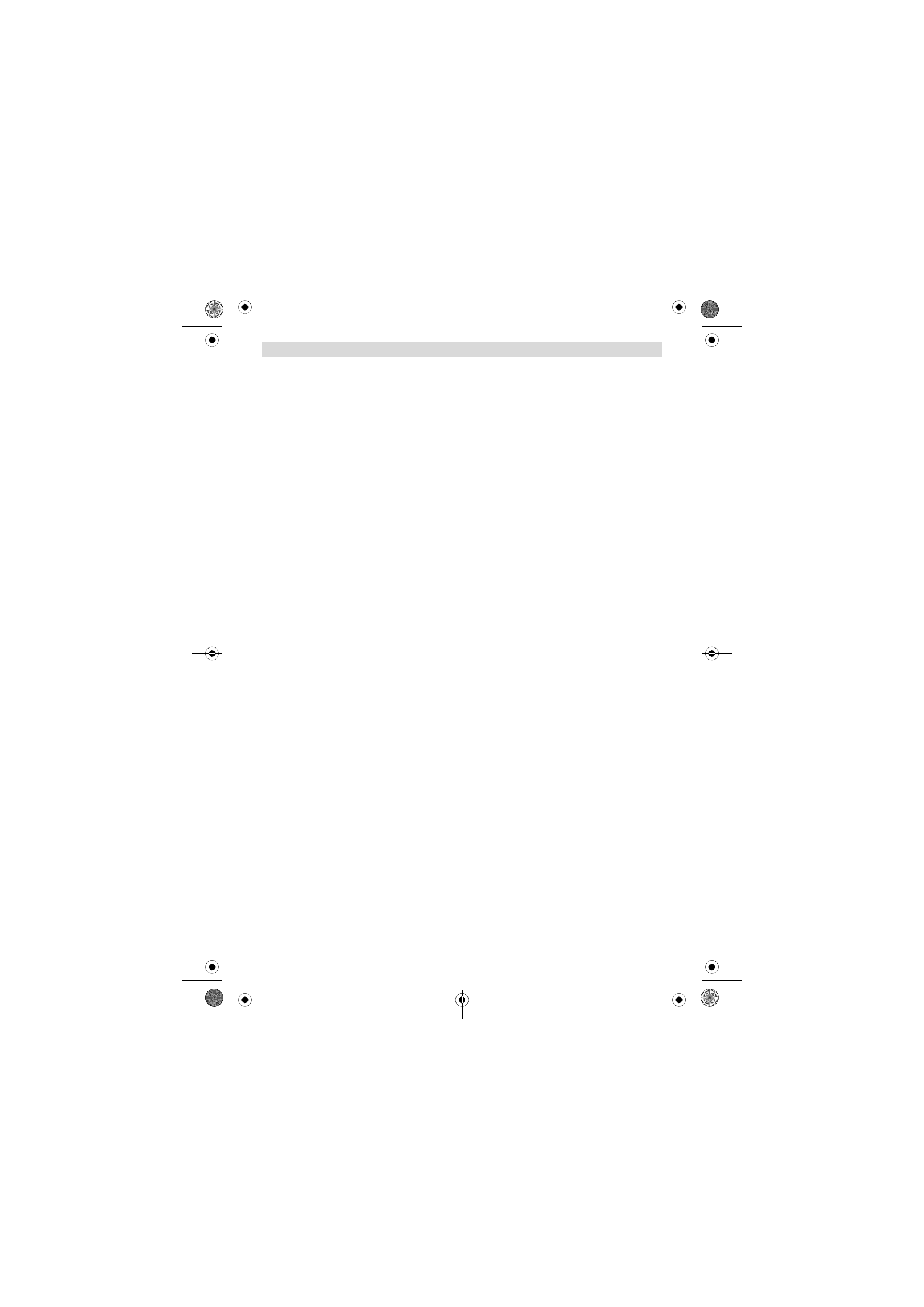
14
| English
1 609 92A 0J8 | (4.7.14)
Bosch Power Tools
Always use undamaged wheel flanges that are of cor-
rect diameter for your selected wheel.
Proper wheel
flanges support the wheel thus reducing the possibility of
wheel breakage.
Do not use worn down reinforced wheels from larger
power tools.
Wheels intended for larger power tools are
not suitable for the higher speed of a smaller tool and may
burst.
The outside diameter and the thickness of your acces-
sory must be within the capacity rating of your power
tool.
Incorrectly sized accessories cannot be adequately
guarded or controlled.
The arbour size of wheels and flanges must properly fit
the spindle of the power tool.
Wheels and flanges with ar-
bour holes that do not match the mounting hardware of the
power tool will run out of balance, vibrate excessively and
may cause loss of control.
Do not use damaged wheels. Before each use, inspect
the wheels for chips and cracks. If power tool or wheel
is dropped, inspect for damage or install an undam-
aged wheel. After inspecting and installing the wheel,
position yourself and bystanders away from the plane
of the rotating wheel and run the power tool at maxi-
mum no load speed for one minute.
Damaged wheels will
normally break apart during this test time.
Wear personal protective equipment. Depending on
application, use face shield, safety goggles or safety
glasses. As appropriate, wear dust mask, hearing pro-
tectors, gloves and shop apron capable of stopping
small abrasive or workpiece fragments.
The eye protec-
tion must be capable of stopping flying debris generated
by various operations. The dust mask or respirator must be
capable of filtrating particles generated by your operation.
Prolonged exposure to high intensity noise may cause
hearing loss.
Keep bystanders a safe distance away from work area.
Anyone entering the work area must wear personal
protective equipment.
Fragments of workpiece or of a
broken accessory may fly away and cause injury beyond
immediate area of operation.
Hold the power tool by insulated gripping surfaces on-
ly, when performing an operation where the cutting ac-
cessory may contact hidden wiring or its own cord.
Cut-
ting accessory contacting a “live” wire may make exposed
metal parts of the power tool “live” and could give the op-
erator an electric shock.
Position the cord clear of the spinning accessory.
If you
lose control, the cord may be cut or snagged and your hand
or arm may be pulled into the spinning wheel.
Never lay the power tool down until the accessory has
come to a complete stop.
The spinning wheel may grab
the surface and pull the power tool out of your control.
Do not run the power tool while carrying it at your side.
Accidental contact with the spinning accessory could snag
your clothing, pulling the accessory into your body.
Regularly clean the power tool’s air vents.
The motor’s
fan will draw the dust inside the housing and excessive ac-
cumulation of powdered metal may cause electrical haz-
ards.
Do not operate the power tool near flammable materi-
als.
Sparks could ignite these materials.
Do not use accessories that require liquid coolants.
Us-
ing water or other liquid coolants may result in electrocu-
tion or shock.
Kickback and related warnings
Kickback is a sudden reaction to a pinched or snagged ro-
tating wheel. Pinching or snagging causes rapid stalling of
the rotating wheel which in turn causes the uncontrolled
power tool to be forced in the direction opposite of the
wheel’s rotation at the point of the binding.
For example, if an abrasive wheel is snagged or pinched by
the workpiece, the edge of the wheel that is entering into
the pinch point can dig into the surface of the material
causing the wheel to climb out or kick out. The wheel may
either jump toward or away from the operator, depending
on direction of the wheel’s movement at the point of pinch-
ing. Abrasive wheels may also break under these condi-
tions.
Kickback is the result of power tool misuse and/or incor-
rect operating procedures or conditions and can be avoid-
ed by taking proper precautions as given below.
Maintain a firm grip on the power tool and position your
body and arm to allow you to resist kickback forces. Al-
ways use auxiliary handle, if provided, for maximum
control over kickback or torque reaction during
start-up.
The operator can control torque reactions or
kickback forces, if proper precautions are taken.
Never place your hand near the rotating accessory.
Ac-
cessory may kickback over your hand.
Do not position your body in line with the rotating
wheel.
Kickback will propel the tool in direction opposite
to the wheel’s movement at the point of snagging.
Use special care when working corners, sharp edges,
etc. Avoid bouncing and snagging the accessory.
Cor-
ners, sharp edges or bouncing have a tendency to snag the
rotating accessory and cause loss of control or kickback.
Do not attach a saw chain, woodcarving blade, seg-
mented diamond wheel with a peripheral gap greater
than 10 mm or toothed saw blade.
Such blades create
frequent kickback and loss of control.
Do not “jam” the cut-off wheel or apply excessive pres-
sure. Do not attempt to make an excessive depth of cut.
Overstressing the wheel increases the loading and suscep-
tibility to twisting or binding of the wheel in the cut and the
possibility of kickback or wheel breakage.
When wheel is binding or when interrupting a cut for
any reason, switch off the power tool and hold the pow-
er tool motionless until the wheel comes to a complete
stop. Never attempt to remove the cut-off wheel from
the cut while the wheel is in motion otherwise kickback
may occur.
Investigate and take corrective action to elimi-
nate the cause of wheel binding.
OBJ_BUCH-280-005.book Page 14 Friday, July 4, 2014 10:30 AM
Содержание
- 134 или подвижных частей электроинструмента.
- 135 ных частиц и частиц материала.
- 136 Дополнительные предупредительные указания
- 137 Описание продукта и услуг; Применение по назначению; Угловая шлифмашина
- 138 Данные по шуму и вибрации; Применяйте средства защиты органов слуха!; Заявление о соответствии; Сборка; Установка защитных устройств; Защитный кожух для отрезания; Установка шлифовальных инструментов
- 139 Быстрозажимная гайка; без отрыва от корпуса; Отсос пыли и стружки; Избегайте скопления пыли на рабочем месте.
- 140 Работа с инструментом; Включение электроинструмента; включения; Указания по применению; Резка металла
- 141 Указания по статике; Техобслуживание и сервис; Техобслуживание и очистка; Россия; Беларусь; Утилизация
Характеристики
Остались вопросы?Не нашли свой ответ в руководстве или возникли другие проблемы? Задайте свой вопрос в форме ниже с подробным описанием вашей ситуации, чтобы другие люди и специалисты смогли дать на него ответ. Если вы знаете как решить проблему другого человека, пожалуйста, подскажите ему :)












































